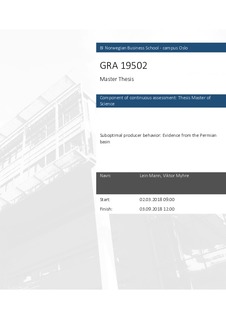| dc.description.abstract | In this master thesis we examine to what extent shale well producers in the
Permian basin respond flexibly in terms of allocating output intertemporally to
price incentives. We use an extensive panel data based on micro data set provided
by Rystad Energy dating back to 2000 until the end of 2017, which covers more
than 13,000 shale wells. Our data indicate that producers are forward-looking and
trade off production today for production in the future. More specifically, our
main finding is that when the 3-month future spot spread increases by 10% well
operators in Permian shift up production by 6.35%, which is significant at a 5%-
level. This result also contradicts previous literature, which found other shale
producers to shift production down or respond insignificantly to similar price
incentives. According to our results, producers in Permian behave in a suboptimal
manner, which opposes the Hotelling rule. We argue that these results are due to
Permian’s explosive growth compared to other U.S. shale regions in recent years,
driven by easy access to investor funding and management incentives related to
production growth. | nb_NO |
